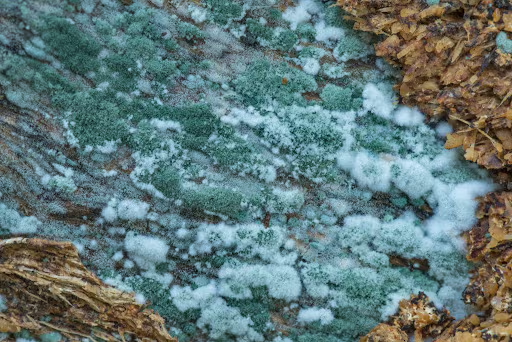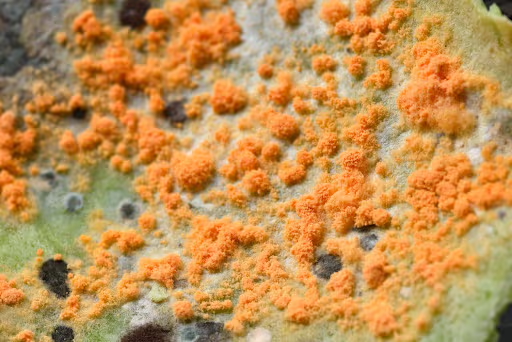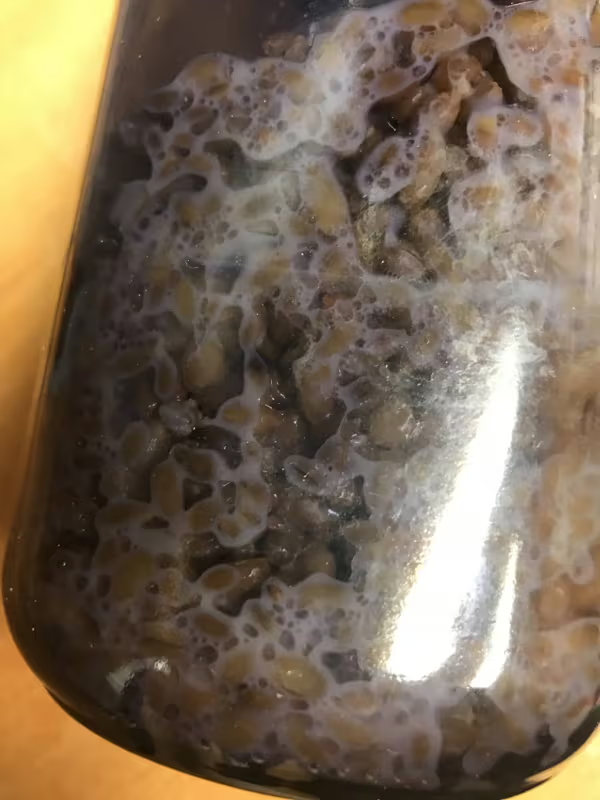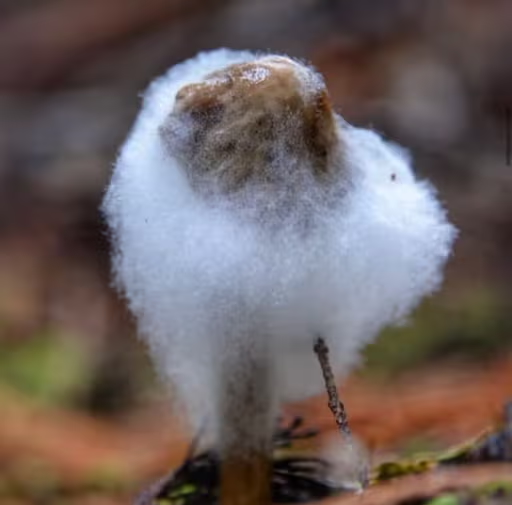Contamination is every mushroom cultivator’s worst nightmare. It can strike unexpectedly, turning a promising batch into a heartbreaking loss. Whether it’s mold, bacteria, or other unwanted invaders, contamination not only halts the growth of your mushrooms but also poses potential health risks. In this article, we delve into the causes of contamination, how to identify it early, and steps you can take to prevent it, ensuring that your cultivation efforts lead to a successful and healthy harvest.
Basic signs of contamination:
Before we get into it, here is a list of the basic signs of contamination in mushroom cultivation:
• Discoloration: Changes in color, such as yellow or brown spots or streaks on the surface of the mushrooms or growing medium.
• Off-odors: A strong, foul odor emanating from the growing containers or growing medium. Sweet and earthy smells are good.
• Abnormal growth: Mushrooms that grow abnormally, such as those that are misshapen or stunted.
• Presence of molds: The appearance of molds, such as white or blue-green growths on the surface of the mushrooms or growing medium.
• Presence of insects: The presence of insects, such as flies or mites on the substrate or fruiting bodies.
If you notice any of these signs, it is important to take action immediately to prevent further contamination. This may involve ditching your tub or jars, disinfecting the growing area, or adjusting growing conditions to improve the overall health of your grow.
4 Common Contaminants

Trichoderma
Trichoderma is a group of green mold fungi that is present in all soils, with several species having the ability to form symbiotic relationships with plants and plant roots. This mold produces white mycelium that will rapidly cover substrates before producing emerald-green spore-bearing structures. In its mycelial stage, it can be difficult to detect as it appears similar to mushroom mycelium. Unlike mushroom mycelium, which appears more rope-like and remains tight on the substrate, Trichoderma has a fluffy appearance that rises from the substrate. If Trichoderma contamination is detected, isolation is key. Removal and disposal of contaminated substrate must happen immediately before it spreads to other substrates including grow bags, jars, and monotubs. Wash affected tools with a bleach solution or alcohol to kill off any spores. If left untreated, Trichoderma is difficult to control and can wipe out an entire crop.

Orange Bread Mold
Orange bread mold, red bread mold, or pink mold are alternative names for Neurospora crassa, another common and extremely fast-growing fungal contaminant. While used for decades in genomics research, this neon orange mold can wreak havoc on your operation in as little as 8-12 hours. It first appears as an orange-white wisp but quickly develops into a bright orange powdery patch. If allowed to grow, these patches produce round lumpy formations, but it is best to catch the fungus prior to this stage. Once found, contain the source by sealing it in a plastic bag and disposing of it immediately, being careful not to disturb the mold as it will release a fine cloud of orange spores into the air which can quickly spread. After disposal, sanitize the affected area and inspect your workspace for the source, which could include discarded coffee grounds, compost, or damp, untreated wood.

Bacillus spp. (Bacterial contamination)
The most common form of bacterial contamination in mushroom cultivation is known as “wet spot” or “sour rot”. It is characterized by a dull gray slime with a sour-smelling odor that appears excessively wet or mucus-like and often forms in uncolonized patches along the bottom of grain jars. Their reproductive structures are called endospores, which are heat resistant, meaning they will survive the sterilization process. To prevent it, grains can be soaked for 12 to 24 hours at room temperature prior to sterilization, allowing the endospores within the grain to germinate and be eliminated during sterilization. If the contamination is encountered, it is possible to separate it from the rest of the myceliated grains (so long as the patch is small and confined to one area) by physically scooping out the patch using an alcohol sanitized or flame sterilized spoon. This can also take place in a monotub with an isolated patch of contamination where mushroom exudate has turned the affected area yellow, indicating an attempt by the mushroom to fight off the rival bacteria.

Cobweb Mold
Growers can prevent cobweb mold by lowering the humidity in their grow chambers and monotubs, which can be accomplished through careful attention to substrate hydration and improving Fresh Air Exchange (FAE) or by physically fanning your grow chamber or monotub several times a day if already in the fruiting stage. If spotted early, cobweb mold can be controlled with a 3% hydrogen peroxide solution sprayed on the infected area. Following direct application, soaking a paper towel in hydrogen peroxide and placing it on the affected area is helpful at controlling future cobweb contamination, in addition to trichoderma and bacterial contamination.
Common Causes:
Contamination in a batch of magic mushrooms can be caused by several factors, each compromising the growth and safety of the mushrooms. Here are the primary causes:
- Unsterile Environment:
- Poor Sanitation: Not properly cleaning the cultivation area, tools, and containers can introduce contaminants.
- Airborne Contaminants: Dust, mold spores, and bacteria in the air can settle on the substrate and mushrooms.
- Contaminated Substrate:
- Improper Pasteurization/Sterilization: Failing to adequately pasteurize or sterilize the substrate can leave harmful microorganisms alive.
- Poor Quality Materials: Using low-quality or already contaminated substrates can introduce pathogens.
- Inadequate Personal Hygiene:
- Handling: Handling substrates and spawn with unclean hands or without using gloves can transfer contaminants.
- Clothing: Wearing unclean clothing while working with the mushrooms can also introduce contaminants.
- Contaminated Spawn:
- Source: Using spawn from unreliable sources can introduce contaminants into your batch.
- Storage: Improper storage of spawn can lead to contamination before it is even used.
- Improper Moisture Levels:
- Excess Moisture: Overly moist conditions can promote the growth of mold and bacteria.
- Standing Water: Water pooling in the substrate can be a breeding ground for contaminants.
- Lack of Air Exchange:
- Stagnant Air during fruiting: Poor ventilation can lead to the buildup of carbon dioxide and create conditions favorable for contaminants.
- Temperature Fluctuations:
- Too Warm: High temperatures can encourage the growth of harmful bacteria and mold.
- Too Cold: Lower temperatures can slow down mycelium growth, allowing contaminants to take hold.
- Cross-Contamination:
- Other Plants or Animals: Proximity to other plants or the presence of pets can introduce contaminants.
- Reusing Contaminated Equipment: Not properly cleaning equipment between uses can spread contaminants from one batch to another.
By addressing these factors through meticulous sanitation, proper substrate preparation, careful handling, and maintaining optimal growing conditions, you can significantly reduce the risk of contamination and ensure a healthy and productive mushroom cultivation process.
Solutions to Prevent Contamination in Magic Mushroom Cultivation
Preventing contamination in your magic mushroom cultivation involves implementing strict hygiene practices, ensuring proper preparation and maintenance of the growing environment, and using high-quality materials. Here are solutions to address the common causes of contamination:
- Unsterile Environment:
- Maintain Cleanliness: Regularly clean and disinfect the cultivation area, including surfaces, tools, and containers. Use a solution of bleach or 70% isopropyl alcohol to sanitize.
- Control Air Quality: Use HEPA filters or air purifiers to reduce airborne contaminants. Work in a cleanroom or still air box to limit exposure to dust and spores. It is also recommended to turn off all fans, and heating/cooling one-hour before starting work to reduce air circulation.
- Contaminated Substrate:
- Proper Sterilization: Thoroughly pasteurize or sterilize the substrate before use. Use a pressure cooker or autoclave to ensure all harmful microorganisms are eliminated. You can also you the sanitize or hight temp feature on the dishwasher if it has one.
- Quality Materials: Source high-quality, pre-sterilized substrates from reputable suppliers to minimize the risk of contamination.
- Inadequate Personal Hygiene:
- Practice Good Hygiene: Wash hands thoroughly and wear disposable gloves when handling substrates and spawn. Consider wearing a face mask and clean clothing to reduce contamination risks.
- Minimize Contact: Avoid unnecessary handling of the substrate and spawn. Use sterile tools and minimize direct contact.
- Contaminated Spawn:
- Reliable Sources: Purchase spawn from reputable suppliers known for their quality and cleanliness. Inspect the spawn for any signs of contamination before use.
- Proper Storage: Store spawn in a cool, dark, and dry place to prevent contamination. Use it promptly to avoid spoilage.
- Improper Moisture Levels:
- Monitor Moisture: Ensure the substrate has the right moisture content—moist but not waterlogged. Use a moisture meter to check levels.
- Avoid Standing Water: Ensure proper drainage in the substrate to prevent water pooling, which can harbor contaminants.
- Temperature Fluctuations:
- Stable Temperature: Maintain a consistent temperature suitable for mushroom growth. Use heating mats, thermostats, or climate control systems to regulate temperature.
- Monitor Conditions: Regularly check and adjust the temperature to stay within the optimal range for the specific mushroom strain.
- Cross-Contamination:
- Isolate Growing Area: Keep the cultivation area separate from other plants, animals, and household activities to prevent cross-contamination.
- Clean Equipment: Thoroughly clean and sterilize all equipment and tools between uses. Avoid reusing contaminated materials.
By implementing these solutions, you can significantly reduce the risk of contamination and ensure a healthier, more productive mushroom cultivation process. Consistent attention to hygiene, environmental control, and the quality of materials will help you achieve a successful and uncontaminated harvest.
Conclusion: Preventing Contamination in Magic Mushroom Cultivation
Contamination can devastate a batch of magic mushrooms, leading to significant losses and potential health risks. By understanding the common causes—such as unsterile environments, contaminated substrates, inadequate personal hygiene, and improper growing conditions—you can take proactive steps to mitigate these risks. Ensuring thorough sterilization, maintaining cleanliness, and providing optimal environmental conditions are crucial for preventing contamination.
Cultivating magic mushrooms requires diligence and attention to detail, but the rewards of a healthy, uncontaminated harvest are well worth the effort. By implementing these preventative measures, you can protect your crops from contamination and enjoy the fruits of your labor with confidence.
Similar Posts About Growing Magic Mushrooms
-
From Bulls to Breakthroughs: Unveiling the Truth About Magic Mushrooms
Have you ever been curious about where magic mushrooms come from? When I was a kid, I was absolutely certain they grew out of cow patties. It wasn’t just a random guess—I’d heard all sorts of stories and rumors about how these mysterious mushrooms would pop up in the most unexpected places. The idea that
-
Stuntetd Growth in Magic Mushrooms: Why so little
Stunted growth in magic mushrooms can be a frustrating challenge for cultivators, often leading to diminished yields and compromised potency. Understanding the root causes of this issue is essential for creating an optimal environment that promotes robust and healthy mushroom development. This guide will explore common factors that contribute to stunted growth and provide practical
-
Contamination: The Tragic Loss of a Magic Mushroom Batch
Contamination is every mushroom cultivator’s worst nightmare. It can strike unexpectedly, turning a promising batch into a heartbreaking loss. Whether it’s mold, bacteria, or other unwanted invaders, contamination not only halts the growth of your mushrooms but also poses potential health risks. In this article, we delve into the causes of contamination, how to identify

